On January 6, 1941, Franklin Delano Roosevelt gave the State of the Union Address citing four essential freedoms. Each point was punctuated with “everywhere” or “anywhere in the world.” While these four have to do with basic human rights, as I gazed upon four of the most advanced, modern, high-performance dual-sports ever produced, set in front of snow-capped Utah mountains, two of FDR’s words rang particularly clear and true: anywhere and everywhere.
Dual sport motorcycles used to be about “most places” but were lower spec and less performance-oriented in comparison to manufacturers’ race bikes. Now dual sports share much with top-of-the-line off-road models. Compromises are fewer, both mechanically and in capability. Any of the dual sports in this motorcycle comparison could be ridden to off-road races, raced, then ridden back home. Any race. And while it is true each might not be 100 percent the top choice as a race bike, they offer a combination of flexibility and performance unavailable in any other dirt bike.
To find the best dual sport motorcycle for anywhere and everywhere, we tested four 450-class machines. The 2019 Honda CRF450L is the impetus for this shootout. It is the first Japanese dual sport to venture into this high-performance category, one created and ruled by European brands. KTM’s 500 EXC-F was a Cycle World Ten Best pick for its torquey engine and light handling. The 2019 Husqvarna FE 450 shares much with the KTM, but has its own premium Swedish flavor—despite being prepared and cooked in Austria—with up-spec parts. The 2019 Beta 430 RR-S has the smallest displacement, but more than makes up for it with its Italian looks and some features not offered by the competition.
In the spirit of these bikes, we could have chosen anywhere for this contest. But off-road mecca Moab, Utah, offers amazing testing environs worthy of these top-shelf dual sports. Rugged terrain with hundreds of miles of challenging trails offer the opportunity to test all aspects of the four machines. Our crew even camped outside of town, ensuring we would get dirt-road and street miles, both day and night. Once we got our Lance Camper and trailer parked, it stayed parked for the next three testing days. All travel, whether it was a ride on the world famous Hell’s Revenge Trail or a quick blast to dinner in town, would be done on the bikes.
The 2019 Honda CRF450L is the newcomer to the dual-sport category and certainly grabbed the the attention of dual-sport riders and off-roaders the minute it was announced. Sharing most details with 2019 CRF450X off-roader means genes of the CRF450R motocrosser are also evident. An aluminum dual-spar frame, the only non-steel frame in the test, holds a Unicam 449cc single-cylinder engine that gets its own EFI mapping and lower compression than the X model to pass sound and emissions regulations. Reliability and legality are key focuses of the CRF450L as a street-legal enduro. But just under the facade of a model citizen hides the makings of a racer. All with the lowest price tag of $10,399.
Beta’s sexy, white and red 2019 430 RR-S features a 431cc DOHC engine that resides in a chromoly steel frame suspended by ZF Sachs suspension. Changes from the off-road enduro models are few—DOT approved lighting, DOT Michelin Enduro tires, and some handy folding mirrors. Some very user-friendly touches set it apart from the competition. A Trail Tech Voyager GPS gauge flat out embarasses the spartan meters found on the other three machines, relaying navigation information, outside temp, and just about every other quantifiable adventure-related parameter. A slick push-button seat release is also handy, especially when we drained the RR-S’s battery on multiple occasions. Unlike the Honda, the $10,499 Beta is on the other end of the “good citizen” spectrum in terms of noise and fury—it is undoubtedly the most rowdy in the group.
Related: 2018 Beta 430 RR-S Review
The 2019 Husqvarna FE 450’s understated white plastic with smooth lines hint at the focus of the Austrian bike with a Swedish name. It shares the same SOHC engine design with KTM’s big-bore EXC-F models at precisely 450cc, and is wrapped with a chromoly steel frame fitted with a very trick carbon-fiber composite subframe/airbox. Up-spec ProTaper handlebars, Magura hydraulic clutch and brakes, D.I.D. Dirt Star wheels, and a linkage rear suspension bump the 2019 Husqvarna FE 450 $11,099 price right up against the bigger KTM 500 EXC-F.
It’s the premium offering of the bunch.
The 2019 KTM 500 EXC-F is the big stick by which all others are measured. Its $11,199 price—highest in the test—will buy you more displacement than Husqvarna, with an 8.6mm longer stroke from its 510cc SOHC single. An aluminum subframe rather than the Husky’s composite unit is attached to a very similar chromoly steel frame. The real difference comes down to the rear suspension: both Austrian-built machines run KTM Group-owned WP Suspension, but the EXC-F is fitted with a PDS (Progressive Damping System) rear suspension. This eliminates the linkage, with a shock fitted directly to the frame and swingarm.
Before we hit the trail, each bike was weighed, measured, and run on the Cycle World dyno to establish hard empirical numbers. Here, the 2019 Beta 430 RR-S ruled the stationary horsepower and torque battle, producing 44.4 horsepower at 8,150 rpm and 32.1 pound-feet of torque at 6,600 rpm—a serious achievement considering its 79cc displacement disadvantage to the almighty KTM; the 2019 500 EXC-F used its 510cc to belt out 41 horsepower at a slightly lower 7,800 rpm with 29.5 pound-feet at a nearly identical 6,700 rpm. The 2019 Honda CRF450L secured a podium finish on the dyno battle with 38.2 hp and 28 pound-feet of torque at 6,500 rpm. Surprisingly, the 2019 Husqvarna FE 450 with a shorter stroke and 60cc less displacement than its KTM cousin, was last with 35.1 horsepower at 8,200 rpm and just 25.5 pound-feet of torque at 6,100 rpm.
Analyzing the dyno charts shows that the power character of the two front-runners is quite different. The Beta’s horsepower, and more importantly torque, are less than KTM in the lower rpm range, then ramp up quickly. Output also drops off quicker as you approach the rev limiter. The EXC-F’s torque curve is much flatter and horsepower doesn’t rise quite as steeply. The Honda is more similar to the Beta, and, as expected, the FE 450 is more like 500 EXC-F, albeit with less of everything throughout the two curves.
And if you are wondering why we chose the 2019 500 EXC-F and not the 2019 450 EXC-F Six Days, it comes down to pricing and availability. While the 450 model is a better fit in terms of displacement, it is a special model with a price tag that bumps up against 12 grand at $11,899—$700 more than a 500 EXC-F.
Production numbers also are low, and the release of the model is months after the standard EXC-F models. The 500 EXC-F is purchased four times as often.
On the trail, power delivery mirrors what you see in the charts. The 2019 KTM is king of torque. Rolling on the throttle produces an immediate, linear, and controllable thrust. This makes for an easy-to-ride character, a more important quality than peak power when managing rear-wheel traction on varying surfaces. It just makes power in the right places for all the places you want to ride.
In contrast to the tractor-like 500 EXC-F, the 2019 Beta 430 RR-S is snappy and quick revving, feeling much more like a woods or cross-country racer. It’s an energetic engine that comes on strong in the midrange and has to be ridden accordingly. This strong output has been achieved with the lowest displacement in the group, which is impressive, but delivery is aggressive and therefore the rider must be as well. Its high-strung nature is a blast, but after three long days on the trail, it becomes tiring. Every rider was happy to get on the Beta 430 RR-S, but also happy to get a break on the more mellow Honda CRF450L or Husky FE 450. In Moab we were not racing. In fact, in some cases, we were just trying to survive.
The 2019 Husky FE 450 ranks third in our books for on-the-trail power character. Although it made the lowest numbers on the CW dyno, it didn’t feel that way on the trail. Yes, power was muted in comparison to the 2019 500 EXC-F and didn’t have the snap of the 2019 430 RR-S, but overall it was linear in its delivery. If a 500 is too much or intimidating for you, this would be an excellent choice. Overall, the testing crew found it “just OK” with no egregious criticism or high praise. Think of it as a quiet partner helping you achieve your adventure goals.
Although the Honda CRF450L outperformed the Husqvarna FE 450 on the dyno, on the trail the power was ranked the lowest in all four of our testers’ note sheets. Right off the bottom there is promising grunt, but power signs off much earlier than the other 450cc machines. Peak power is in the ballpark, but the rpm range in which it is delivered is much narrower, making for a bike that feels choked up just as you think it is about to hit its stride. It also was easier to stall; multiple times Big Red flamed out on the rock ledges of Moab. We blame the vague cable-actuated clutch that has a very narrow friction zone.
It’s clear each company’s emissions and sound strategies shape the power character of its dual sport. Honda took no chances in dealing with the EPA and CARB. The exhaust has a catalytic converter, plastic engine covers dampen engine noise, and the rear sprocket has a rubber ring to lessen chain noise, all of which makes it beautifully quiet. Beta, on the other hand, seems to push the limits here. The exhaust note is sharper and louder, the tires are more aggressive (and louder); it doesn’t seem much different than the off-road-only RR version. The KTM and Husqvarna fall somewhere in between the two, using reed valves in the airbox to reduce intake noise, as well as less aggressive (quieter) stock tires.
Consider the countries each is from and their differing engineering philosophies, and it all makes sense. Japan, engineered for the best value, durability and wide-margin legality, leaves nothing to chance. Austria follows the rules, but pushes the limits right to the edge. Italy, well, rules are often meant to be bent.
On one of the less technical but rougher trails named Fins N Things, we found an entertaining mix of slick rock, sand whoops, and bone-jarring rock fields, giving us the opportunity to test suspension right away. On the rocky, choppy sections the KTM 500 EXC-F’s WP Xplor fork and PDS shock were the stars here. Although stiffer fork springs with revised damping for the new year model aimed to make the 2019 KTM 500 EXC-F a bit firmer than last year, it still rolled through the rougher rock fields and sharp-edged veins of sandstone with a compliant but aggressive demeanor. The linkage-less rear suspension also plowed through the chop with stability, deflecting less often and without the harshness of the Honda. And, if you like to sit down while riding, the KTM is your machine.
Where the KTM was at a disadvantage was in the sandy whoop sections; this is where the Honda was at home. The 2019 CRF450L’s bottoming resistance and stability at big speeds and in big bumps is far above any other dual sport in this test. Gone are the days of squishy, wallowing dual sports for Honda; this thing is hare-and-hound ready for average-sized riders. Even bigger riders might not need a revalve and respring.
At lower speeds in rough terrain, though, the Honda was harsh. It wants—no, it begs—to be ridden hard and fast. Backing out compression damping at both ends helped its slow-speed manners, but it was still happier the faster you went.
Husqvarna’s combination of a fully-adjustable (including spring preload) WP Xplor fork and DCC shock with linkage gives a balanced, yet softer ride than the KTM, Honda, and Beta. This is not a bad thing at all, but when going hard in whoops or off jumps, the 2019 FE 450 seems to be less composed than the stiff Honda. At a sane trail pace and on more technical trails, the linkage rear end followed the ground the best, making for excellent traction when things get slick or loose. One test rider preferred the 2019 FE 450’s suspension over the other three because of its exceptionally balanced feel. The rear also rides lower in the stroke than the KTM’s PDS setup. The KTM is on its toes, while the Husky is on its heels.
Not all of the testing team were familiar with the ZF Sachs suspension on the Beta and were skeptical that it could hang with the more familiar Showa and WP units.
Just a few minutes into the dirt and it was clear that was not the case. While not as stiff as the Honda, the 2019 Beta 430 RR-S handled big hits with excellent bottoming resistance but also floated through the chop as well as the KTM and Husky. The crew was split 50/50 on whether the 430 RR-S or 500 EXC-F was the best overall for suspension action.
Connecting to Poison Spider and Cliff Hanger, the next two trails on our hit list, required riding asphalt. While only about 10 miles each way, it was enough to know without question which bike was the king of the street. With the smoothest running engine, the 2019 Honda CRF450L was the most tolerable—at least after the sun came up. When ambient temps were hovering just above freezing, the Honda’s lack of handguards had us cursing their glaring omission. The KTM and Husky both had the most vibration on the street, with a tad bit more than the Beta.
Once on Poison Spider, the KTM jumped to the top of the handling list, with the Beta hot on its heels. Throwing around the 245-pound 2019 500 EXC-F showed just how nimble a 500cc dual sport can be. On the fast fire-road-like sections, it carved arcing slides without drama, and on tighter, technical rock climbs it was able to change direction in a snap. The roomy cockpit gave plenty of space to move and muscle the bike when the situation called for it, but it was just as happy being finessed. This is why the 500 EXC-F wins shootouts year after year.
Where the orange machine was rock solid at high speed, the 2019 Beta 430 RR-S was flightier and quicker to shake its head. It was in no way overly nervous, but it just felt as if you had to pay more attention when at full chat. That quick character made the 430 RR-S a dream as soon as the trail called for any type of technical precision. Beta’s trials roots shine through the nastier it gets. Although it weighs 11 pounds more than the KTM, it didn’t ever feel like it.
The Husky also found fans in the middle ground, where the trail speed was moderate but not really technical or super fast. The Austrian Swede could rip wide open on the roads and get through the nasty bits, but it seemed at either extreme it just wasn’t as good as the competition. In the middle, however, it was the best; for the average rider the FE 450 could be the top choice. At just 3 pounds heavier (248 pounds) than the EXC-F, it felt heavier than that mostly as a result of its less impressive engine performance.
Then there was the Honda CRF450L, the 279-pound victim of very high engineering and compliance standards. It’s a good-handling motorcycle, it’s just going up against lighter, great-handling machines.
It all comes down to weight—you feel it in every situation, and after three days of hard riding and harder trails, as your stamina fades you notice it even more. The CRF can still rail a rut and is more capable than most riders, but a diet of lightweight parts would bring the Honda straight to the front of the class. While it does feel over-engineered, it also feels rock-solid and vault-like in its durability and operation.
On the aptly named Cliffhanger, the trail takes the rider hair-raisingly close to drops that would end you and the motorcycle so completely, the coroner wouldn’t know where you ended and the bike began. Here, clearly, brakes are of the utmost importance. Once again the 2019 KTM 500 EXC-F stood out with powerful and communicative Brembo units. Just behind comes the 2019 Husqvarna FE 450 with Magura hydraulics that offer a softer bite, but the power was plenty strong. The Nissin units of the 2019 Beta 430 RR-S have less feel and more than a few times riders complained that it was too easy to lock the front wheel. The 2019 Honda 450Ls stoppers do their job and do it without complaint. Not one test rider had a good or bad word about them.
Dual sports allow off-roaders to stretch their horizons, as long as it is about 90 miles or less at a time. With motocross-like ergonomics taking priority, fuel-tank capacity on this class of dual sport are just slightly more than their racer counterparts. The 2019 CRF450L’s 2.0-gallon tank has the smallest capacity with a range just shy of 70 miles if ridden hard. Not much better is the Beta 430 RR-S, covering around 70 miles on a 2.1-gallon tank. The KTM 500 EXC-F and Husky FE 450 were similar with around 90 miles range from their 2.2-gallon tanks.
And in a place like Moab, you will want to ride many tankfuls of the finest 91-octane Utah has to offer. In the end, which bike would you want to fill up over and over again? Our crew was unanimous with its choices—all the way down the line. While the Honda is a great first effort in this highly competitive class, by being so very Honda, the CRF450L falls short. Put it on a diet and fix the clutch, and the CRF450L could easily be at the top of the list. While the FE 450 is beautifully capable in the middle of the road, at the extremes it just didn’t perform like the Beta and KTM. The 430 RR-S put up one heck of a fight, but at the end of the day the crew always gravitated to the orange bike. Once again the KTM 500 EXC-F is the dual sport to which all others are compared, with the broadest performance envelope. It really is the dual sport for anywhere and everywhere.
Because we would push these dual sports to the limit, we needed more aggressive tires than what’s delivered from the factory. The KTM and Husqvarna come equipped with Continental TKC 80 tires, while the 2019 CRF450L is fitted with IRC GP21 and GP22 rubber, all meant to help the bikes pass noise tests—not the tires of choice for extreme off-road conditions. The Beta’s single-track worthy Michelin Enduro tires work great out of the box, but to assure parity, we installed Metzeler 6 Days Extreme DOT knobbies, a premier dual sport tire that will give us all the traction we need. Over three days the tires performed admirably in sand, on slick rock—which isn’t slick at all—and on the street.










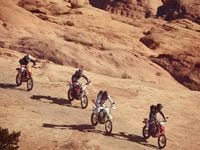
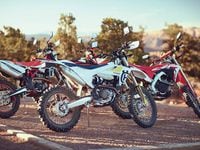


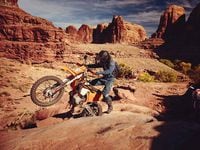
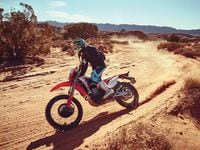
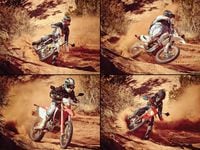
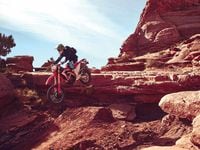
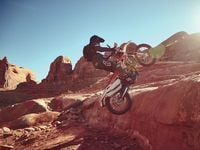
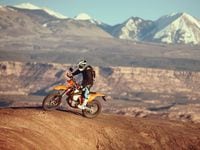
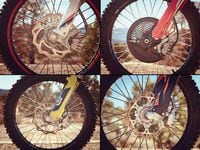
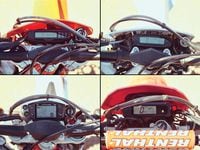
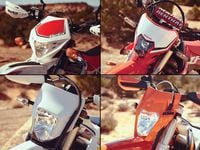
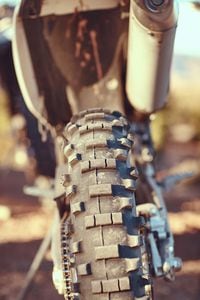
/cloudfront-us-east-1.images.arcpublishing.com/octane/2PLTVHXY7FDSPFHKU5CFOC43ZY.jpg)
/cloudfront-us-east-1.images.arcpublishing.com/octane/B6M3WTRLFZGNXBEATNXPVGBBD4.jpg)
/cloudfront-us-east-1.images.arcpublishing.com/octane/4CMH3FI73BEM5D6MFYX42FLDSQ.jpg)
/cloudfront-us-east-1.images.arcpublishing.com/octane/RIHAPYNWU5H3XAOXNOPRWCBTQA.jpg)
/cloudfront-us-east-1.images.arcpublishing.com/octane/HU4NUBCL3VAFZA75VYRCMAUHVM.jpg)
/cloudfront-us-east-1.images.arcpublishing.com/octane/OB43AZK7TRA6XLZL5WRDVW2TDA.jpg)
/cloudfront-us-east-1.images.arcpublishing.com/octane/5G44Y3FXWNFSTEQKCA355PXOPU.jpg)

/cloudfront-us-east-1.images.arcpublishing.com/octane/XRI4GTLCVBA5NESASCBIR5LYQI.jpg)
/cloudfront-us-east-1.images.arcpublishing.com/octane/EF7566PXARGMBAOMLWTECYL3LE.jpg)
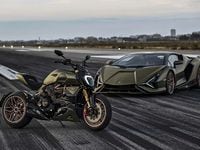
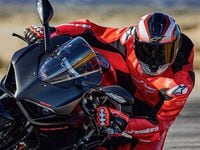

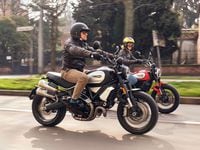
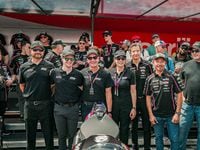
/cloudfront-us-east-1.images.arcpublishing.com/octane/3LASNXSWUZFFPISURDJF3OCWBU.jpg)
/cloudfront-us-east-1.images.arcpublishing.com/octane/2BHJKWUTBNBTLMQCKDNVEG6DKQ.jpg)
/cloudfront-us-east-1.images.arcpublishing.com/octane/MPHXIIV54NAU5L6E4SYZHCXVRM.jpg)



/cloudfront-us-east-1.images.arcpublishing.com/octane/WYXFHF4ZOBBTXELIZDB2FJXU64.jpg)
/cloudfront-us-east-1.images.arcpublishing.com/octane/K5FNV7ONUVDXJJ2H5BIWUGBGTI.jpg)
/cloudfront-us-east-1.images.arcpublishing.com/octane/MGVKP5VTNJHQ7FWNAHIWX4OHO4.jpg)